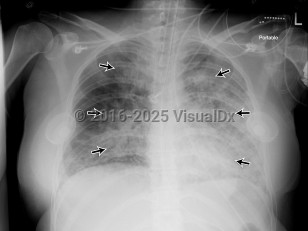Acute respiratory distress syndrome
Alerts and Notices
Important News & Links
Synopsis

Clinically, ARDS is characterized by decreased compliance in the lungs ("stiff lungs"). On a microscopic level, it involves alveolar edema due to increased permeability from membrane destruction ("leaky capillaries") as well as neutrophil infiltration, which can lead to activation of a localized inflammatory response. Once the alveoli are damaged, they will start to collapse, leading to atelectasis derecruitment of the lung. Although mechanical ventilation is the mainstay of treatment, it can be challenging and must be done carefully and within specific parameters, as repetitive re-expansion and collapse of the alveoli can lead to mechanical injury known as atelectrauma and the elevated mean airway pressures or excess tidal volumes in the setting of decreased lung compliance result in alveolar barotrauma / volutrauma.
The Berlin Definition of ARDS was published in 2012, identifying specific criteria for diagnosis.
Related topics: respiratory distress syndrome in the newborn, respiratory failure
Codes
J80 – Acute respiratory distress syndrome
SNOMEDCT:
373895009 – Acute respiratory distress
Look For
Subscription Required
Diagnostic Pearls
Subscription Required
Differential Diagnosis & Pitfalls

Subscription Required
Best Tests
Subscription Required
Management Pearls
Subscription Required
Therapy
Subscription Required
Drug Reaction Data
Subscription Required
References
Subscription Required
Last Updated:03/22/2023


